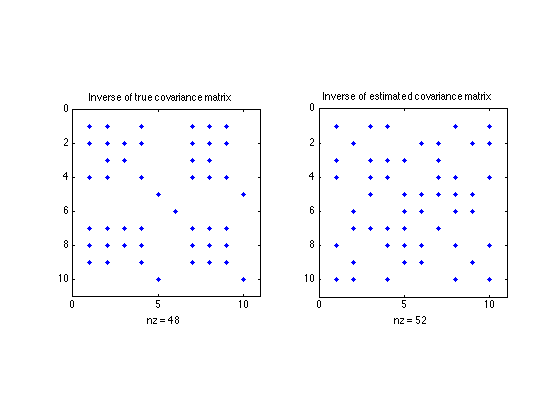rand('state',0);
randn('state',0);
n = 10;
N = 100;
Strue = sprandsym(n,0.5,0.01,1);
R = inv(full(Strue));
y_sample = sqrtm(R)*randn(n,N);
Y = cov(y_sample');
alpha = 50;
cvx_begin sdp
variable S(n,n) symmetric
maximize log_det(S) - trace(S*Y)
sum(sum(abs(S))) <= alpha
S >= 0
cvx_end
R_hat = inv(S);
S(find(S<1e-4)) = 0;
figure;
subplot(121);
spy(Strue);
title('Inverse of true covariance matrix')
subplot(122);
spy(S)
title('Inverse of estimated covariance matrix')
Successive approximation method to be employed.
SDPT3 will be called several times to refine the solution.
Original size: 503 variables, 280 equality constraints
1 exponentials add 8 variables, 5 equality constraints
-----------------------------------------------------------------
Cones | Errors |
Mov/Act | Centering Exp cone Poly cone | Status
--------+---------------------------------+---------
1/ 1 | 1.843e+00 3.337e-01 0.000e+00 | Solved
1/ 1 | 2.766e-01 6.363e-03 0.000e+00 | Solved
1/ 1 | 4.484e-03 1.630e-06 0.000e+00 | Solved
0/ 0 | 1.487e-05 0.000e+00 0.000e+00 | Solved
-----------------------------------------------------------------
Status: Solved
Optimal value (cvx_optval): -31.2401
